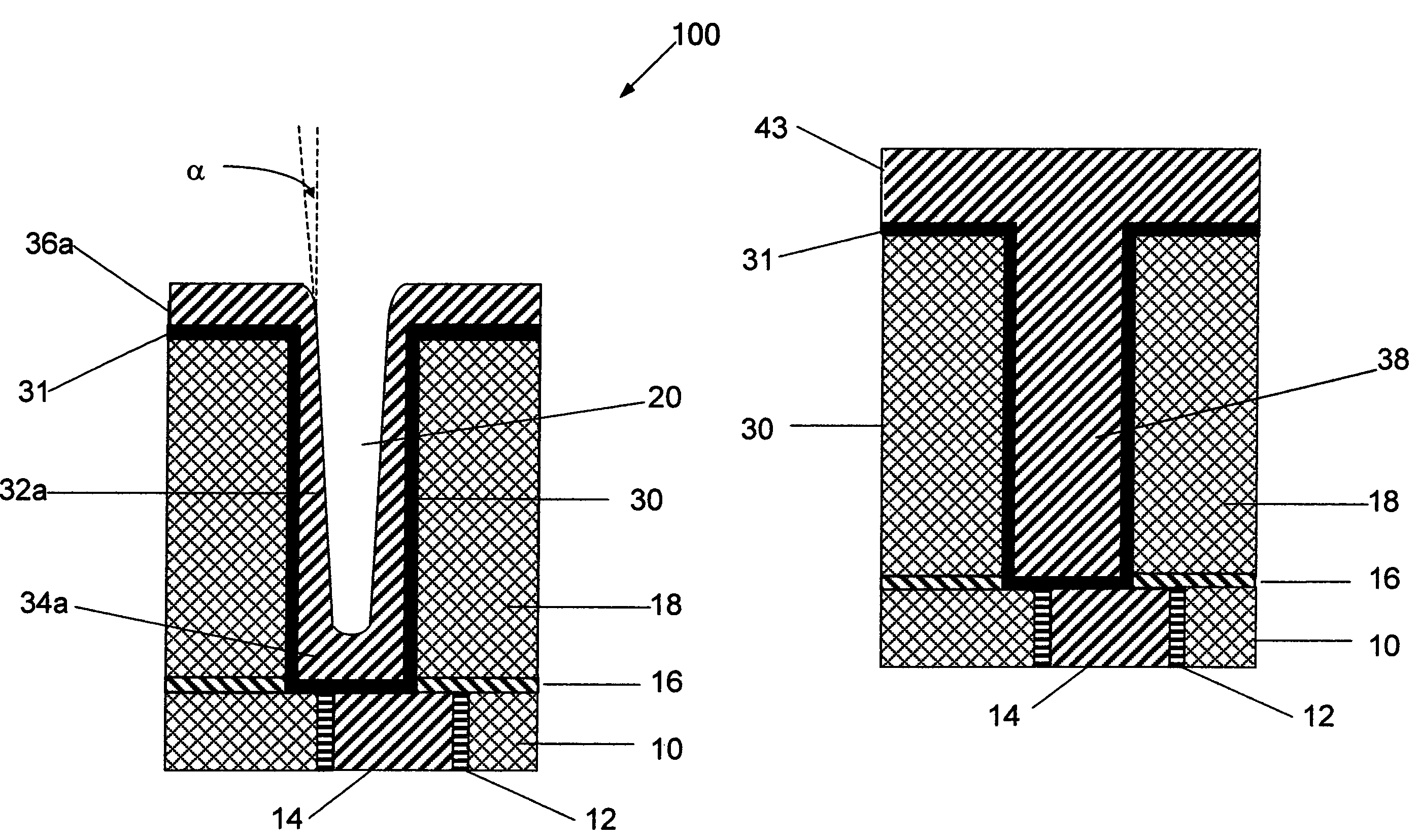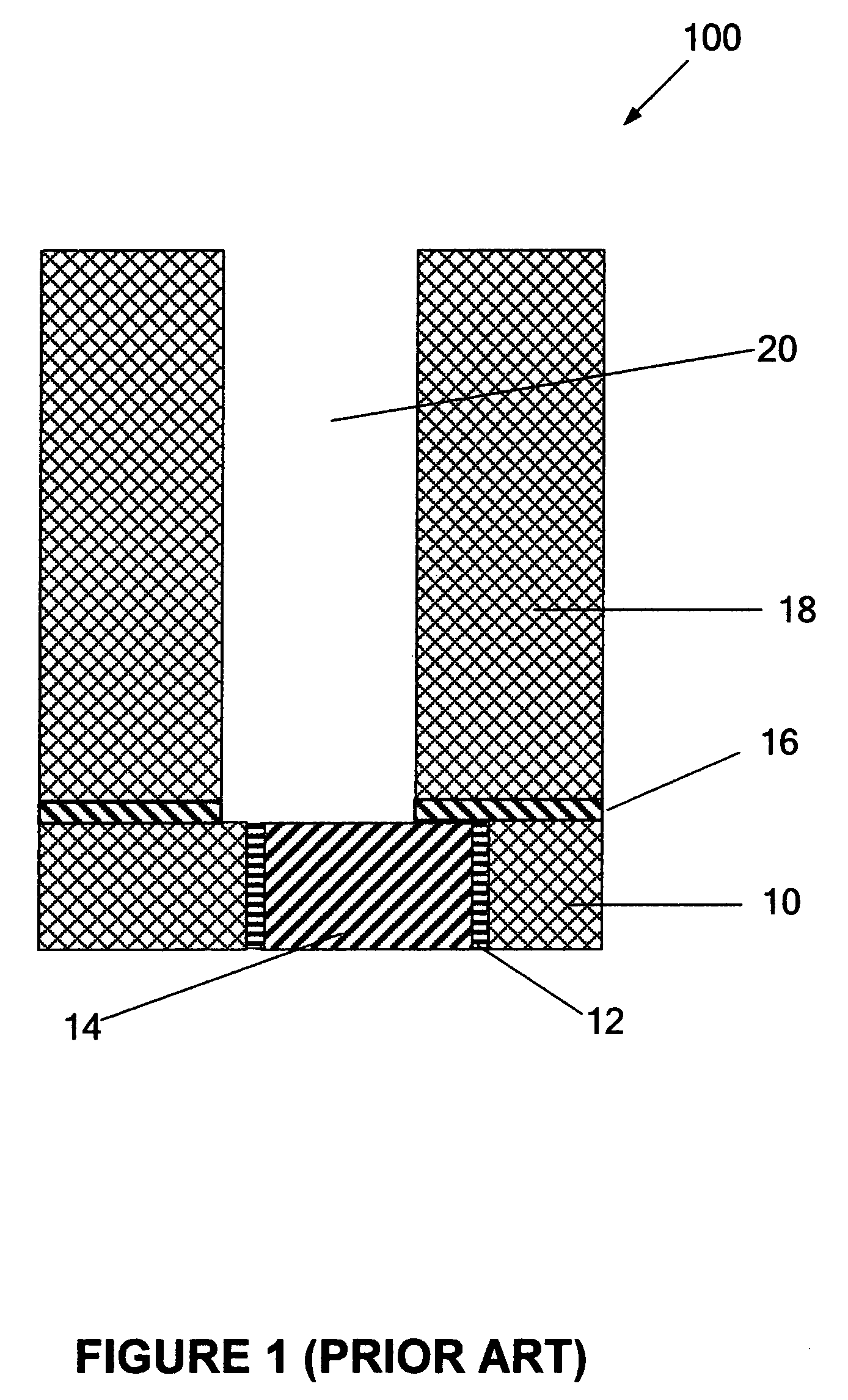However, copper tends to diffuse in to the adjacent
layers of a
dielectric material during operation of the circuit under the influence of electrical field and high temperatures generated due to large operational current densities.
This can lead to short-circuiting two adjoining copper conductors and destruction of an active device.
The copper precursor [Cu(thd)2] employed in this process, however, is a low volatility
solid with a significantly large
molecular size which may hinder surface coverage of the substrate in an ALD process.
Both
copper deposition processes described above employ aqueous solutions of these chemical reagents, which makes copper susceptible to oxidation.
The aqueous process is also susceptible to difficulties encountered to transport viscous liquids into narrow sub-micron device features, which would tend to narrow further increase further with advancing device generations.
Moreover, this method of copper gap-fill does result into finite amount of
copper deposition on the flat surface of the substrate which necessitates application of Chemical Mechanical
Polishing (CMP) process to remove this and underlying copper
diffusion barrier layer.
Apart from low volatility and potentially high cost and complexity of the copper chemical precursor molecule, the copper ALD process described above operates at higher temperature for the tolerance of delicate low-k
dielectric materials.
In addition to this, atomic
hydrogen tends to rapidly recombine on
metal surfaces leading to its depletion in deep and narrow trenches.
Thus in absence of an efficient mechanism to transport atomic
hydrogen effectively and in sufficient quantities within etched features over the entire
substrate surface, it would be difficult to realize an effective copper ALD process from CuCl and atomic hydrogen.
The copper chemical precursors employed in the copper deposition processes described above are low volatility and large organometallic molecules that are generally expensive.
Moreover, their vapor phase dissociation, by application either of heat or
plasma, is seldom clean and it tends to incorporate undesirable impurities such as carbon,
fluorine and others that adversely affect the purity, resistivity and also adhesion of the
resultant copper layer to the underlying
diffusion barrier.
However the approach as outlined above has a number of serious pitfalls:(a) Inadequate step coverage by
sputtering of barrier in small vias and trenches: As the critical device dimensions reduce with each advancing device generation, the vias and trenches are becoming increasingly smaller from 0.13 to 0.10 micron and even below while
aspect ratio is steadily increasing.
As a result, conformality of barrier deposition by this method is becoming increasingly inadequate.
This has led to significant and adverse
impact on the quality of copper seed layer and subsequent copper gap fill process extending into the overall device quality.(b) Poor conformality and discontinuity of copper seed layer by
sputtering: Thin copper seed layer as sputtered on the underlying diffusion barrier also shows inadequate degree of conformal deposition and at times spatial discontinuity and non-uniformities over the contours and surfaces of the structures.
However, any discontinuity in this layer has serious consequences for the next step of electrochemical copper deposition which requires a physically continuous copper layer.
Thus reliability and quality of the device in terms of important functional parameters such as
electromigration resistant can be seriously compromised if this step is not performed satisfactorily.(c)
Corrosion due to wet
electrochemistry: This is a very serious issue that is under active investigation.
The CMP or the other processes employed to remove copper such as
dissolution of copper in acidic solutions, reverse anodic electro-
dissolution of copper are fraught with
corrosion of copper.
This may result in to undesirable scenarios: generation of
high pressure localized steam that may lead to violent rupture of the interconnect structure or it may set up localized galvanic cells to initiate copper
corrosion.
Moreover, in-situ
corrosion due photoelectrons has been an added issue.
All these factors have a significant and adverse
impact on the yield, reliability and overall stability of a copper metallization interconnect scheme being practiced currently.(d) Dishing and
erosion in CMP: During CMP the
wafer surface is polished by rotating and pressing it against a flexible pad on to which an aqueous
slurry containing a chemically
active agent (chlorides of iron etc.) and an
abrasive powder (such as ceria—CeO2) is spread.
Further to this, CMP may lead to micro-scratches, embedded undesirable solids and corrosive material residue on the surface.
This adds to the expenses and can be a substantial part of the final cost and operation.(g) Cost of multiple tools and spare hardware and process
consumables: The metallization scheme, as outlined above, has three distinct process steps that require a separate
process module each.
It thus entails substantial operating costs to the owner per tool in terms of expensive fab floor space, tool operation, maintenance, and process chemical consumption and also cost of each tool maintenance and process
consumables.
All these factors add to the cost-of-ownership significantly.
In summary, the existing multiple
process equipment and their operation suffer from various drawbacks and issues that adversely impinge on the cost, reliability and device yield.
Moreover, the current equipment as described above, may not be easily extendible for the upcoming smaller device dimensions.
Also, long durations of dry
nitrogen purge can slow the overall process sequence and make it uneconomical.
The current ALD equipment, however, is woefully inadequate to process thicker films.
An anti-conformal filling process with a non-uniform deposition on the side walls invariably led to a void in the center of the feature whereas a perfectly conformal filling process with uniform deposition on the side walls and also the bottom of the feature resulted into a seam at the middle which is an undesirable defect and thus cannot be satisfactorily employed for the gap-fill purpose.
Thus a conformal and an anti-conformal filling of a sub-micron feature were both shown to be highly defect-prone.
Also, during an etch back process, employed for removal of excess deposition on the top surface, a defective filling of the feature can either begin to open up rapidly or be filled with the reactive fluids employed in the excess
material removal process thus leading to full destruction of a highly critical void-free gap-filled structure required for high quality device fabrication.
ALD process is also relatively temperature uniformity insensitive.
Also, with the introduction of
temperature sensitive low-k dielectric materials, higher process temperatures have become unacceptable.
The ALD process, however, is significantly slower as compared to a CVD process that can operate at a rate of several hundreds of Ångstrom / minute.
Such an operational handicap can very well lead to restricting application of ALD to only a few tens of Å thin films e.g., diffusion barriers or gate dielectrics.
 Login to View More
Login to View More 


